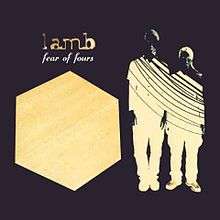Fear of Fours
| Fear of Fours | ||||
|---|---|---|---|---|
 | ||||
| Studio album by Lamb | ||||
| Released | 17 May 1999 | |||
| Genre | Trip hop, drum and bass, jungle | |||
| Label | Mercury | |||
| Lamb chronology | ||||
| ||||
| Professional ratings | |
|---|---|
| Review scores | |
| Source | Rating |
| Allmusic | |
| Entertainment Weekly | B[2] |
| Pitchfork Media | (8.5/10)[3] |
| Q | |
| Rolling Stone | |
Fear of Fours is the title of Lamb's 1999 album. It was a moderate success, reaching UK #37, the band's only UK Top 40 album entry to date.
Track listing
- "Soft Mistake" – 3:15
- "Little Things" – 3:18
- "B Line" – 2:51
- [untitled] – 0:07
- "All in Your Hands" – 4:38
- "Less Than Two" – 1:18
- "Bonfire" – 4:23
- "Ear Parcel" – 7:54
- "Softly" – 3:55
- "Here" – 3:22
- "Fly" – 5:14
- "Alien" – 4:08
- "Five" – 5:46
- "Lullaby" – 2:56
- On the CD release of the album, an alternate version of "Lullaby" is hidden in the pregap, which can be found by rewinding the CD back before the first track. The Spotify version places this at track 1.[6] The Australian version has extra remixes of the album's tracks.
Unusual additions and time signatures in the album
The fourth track is not included on the album's track listing. It is a single struck chord which effectively ends the song "B Line" preceding it. This deliberate omission is a nod to the album's title, whose sentiment is revealed in a deeper level throughout the album: unusual time signatures. "Soft Mistake" is in 10/8. "B Line" is driven by a prominent bass line in 6/8, followed by the single note track 4. "Less Than Two" is in 12/8, backed by a repeating twelve beat phrase "needing you wanting you loving you holding you", and "Softly" is in 6/8. "Alien" continues in 12/8, although the rhythms are at times ambiguous. "Five", the most intricate yet, is in 5/8,5/8,5/8,5/8,5/8,6/8,5/8,6/8, which could also be written as 10/8,10/8,11/8,11/8. "Lullaby" rounds off the album in a slow, lazy 3/4 time. "Little Things" has a rather complex rhythmic pattern, which nevertheless converges to 4/4, or a multiple, depending on notation.
However some of the tracks are more conventional: "All In Your Hands", "Bonfire", "Ear Parcel", "Fly" all have time signatures which are at least divisible by 2 or 4, even though they may not be written as 4/4 per se. "Here" again has a 4/4 structure to it, though the bass plays rhythms which stress this as 3+3+2/8.
References
- ↑ Allmusic review
- ↑ Entertainment Weekly review
- ↑ Pitchfork Media review
- ↑ Aston, Martin. "Review: Lamb - Fear Of Fours". Q. EMAP Metro Ltd (July 1999): 118.
- ↑ Rolling Stone review
- ↑ https://open.spotify.com/album/7tFRNYutf1ADebzALVBBt8